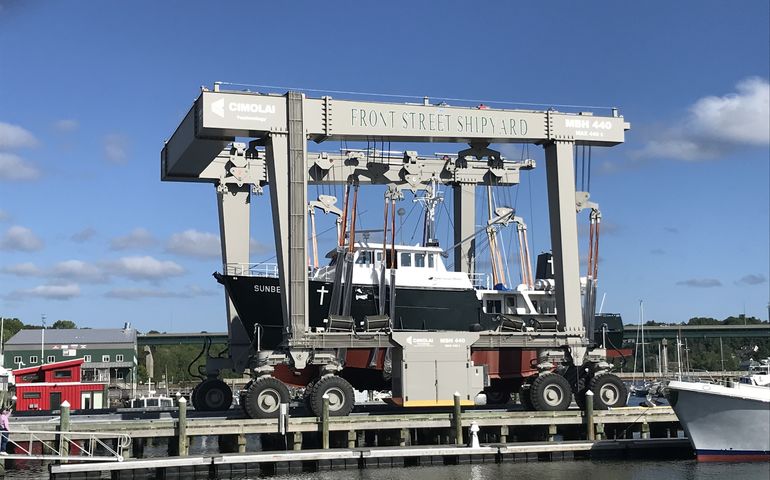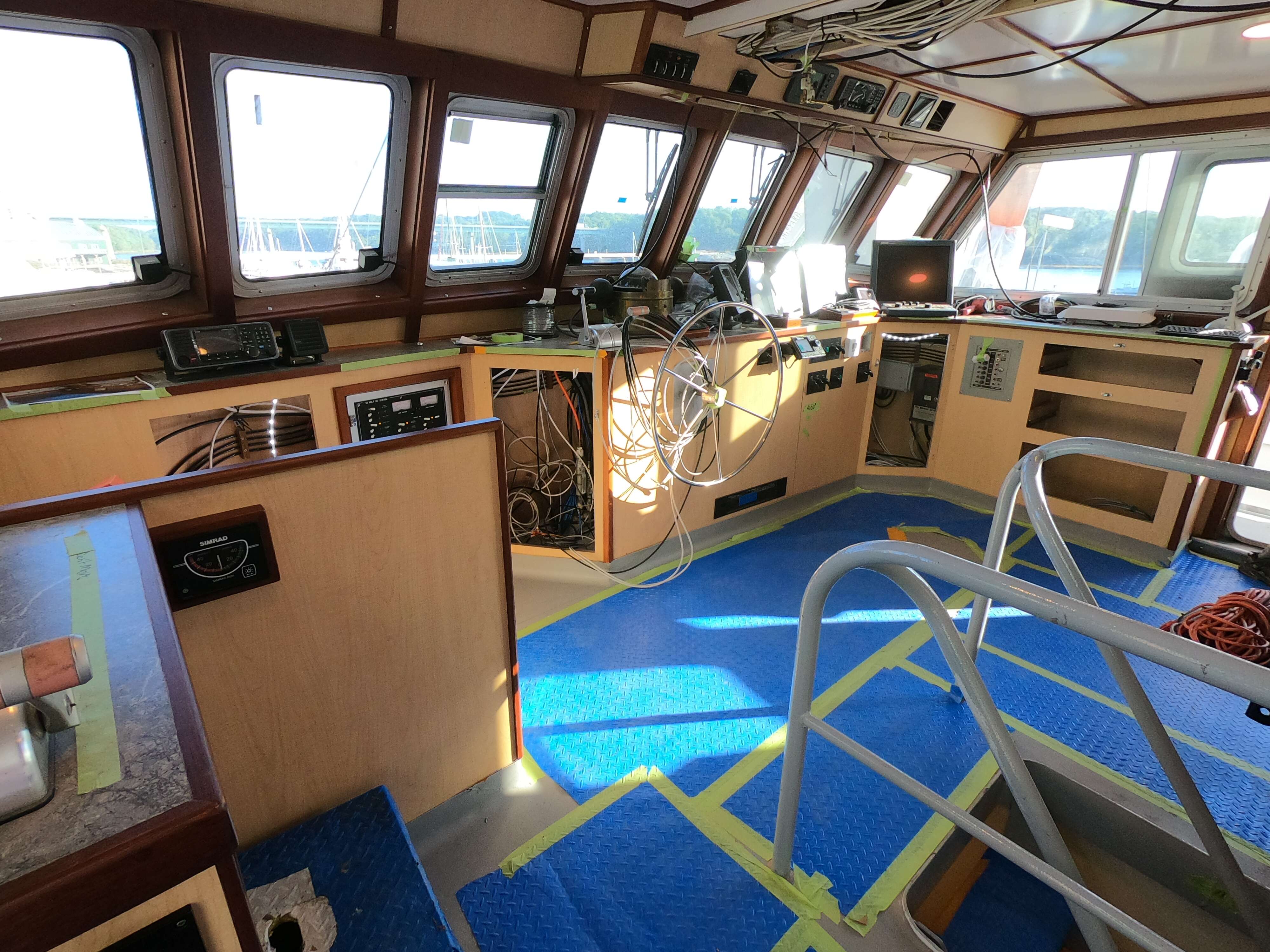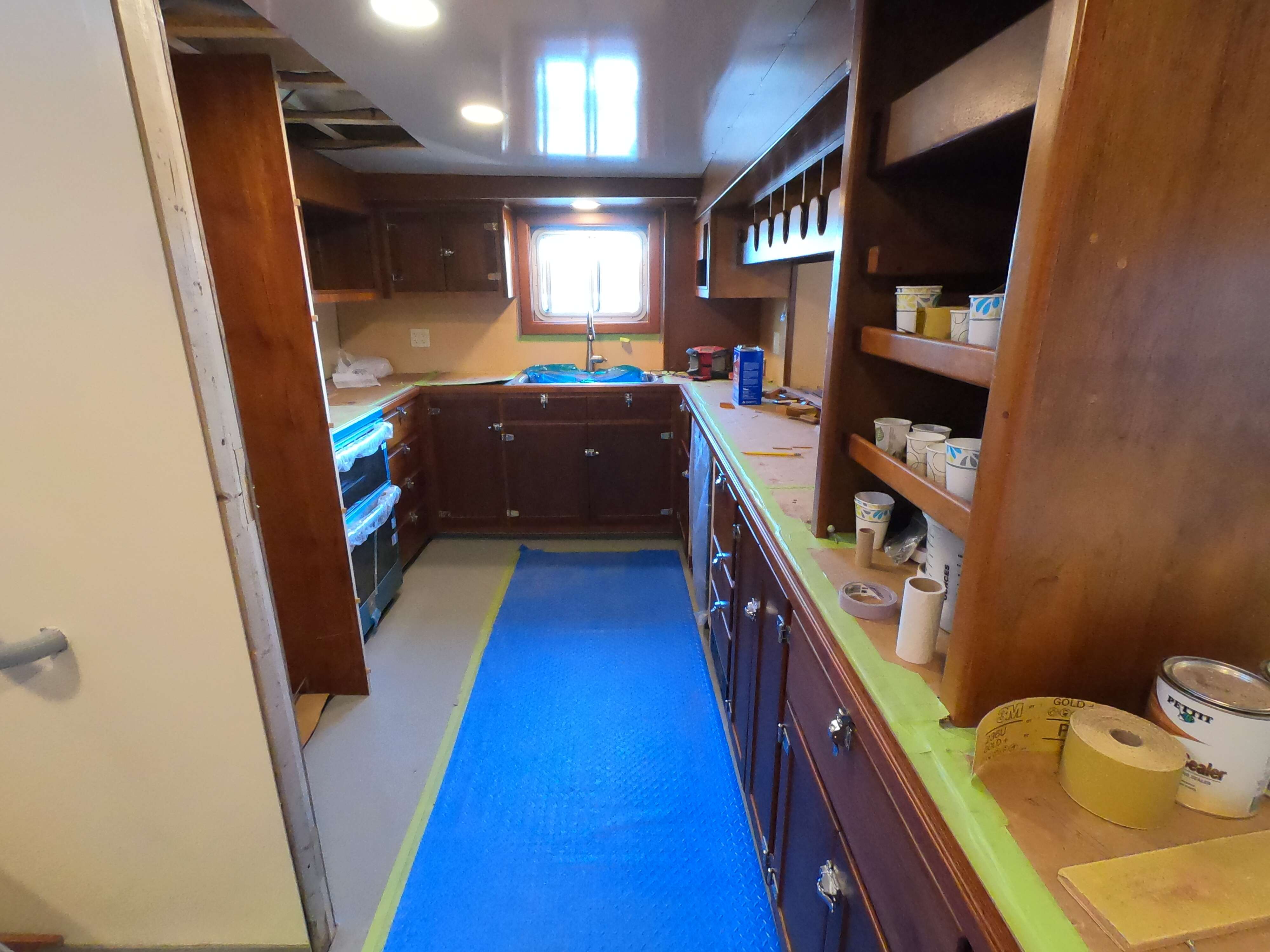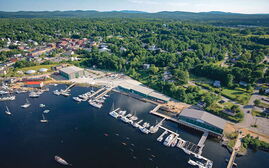
Seacoast Mission’s Sunbeam V splashes after year-long refit
 Courtesy / Front Street Shipyard
The Sunbeam V getting ready to launch on Aug .17.
Courtesy / Front Street Shipyard
The Sunbeam V getting ready to launch on Aug .17.
Front Street Shipyard in Belfast launched Maine Seacoast Mission’s 75-foot-long telemedicine vessel Sunbeam V on Monday, after a 14-month refit.
System tests performed at the shipyard’s dock are now underway, to be followed by sea trials.
Delivery to the mission, which is relocating from Bar Harbor to Northeast Harbor, is expected by early October.
The Sunbeam V arrived at Front Street in May 2019.
The ship underwent extensive hull maintenance, cosmetic updates and equipment upgrades, Front Street's president, JB Turner, told Mainebiz.
The scope of the project changed early on, because there was more corrosion throughout the vessel than initially thought, he said.
“Once that was determined, it was pretty straightforward,” he said of the work.
Delivery was originally scheduled for May, but the pandemic slowed the project, he added.
The mission raised $1.5 million for the refit and ancillary costs such as air flights to Matinicus in order to continue services to the islands. The nonprofit's FY21 budget is $3.5 million.

Since its founding in 1905, the Maine Seacoast Mission has always had a boat to serve the islands.
Maine Seacoast Mission provides medical and dental care to underserved coastal and island communities, as well as pastoral and spiritual support for those seeking it.
The mission’s current vessel, Sunbeam V, has been delivering healthcare and other vital services between Maine’s islands and the mainland since its launching in 1995. It was built by Washburn & Doughty in East Boothbay.
One of Sunbeam’s most important services is its telemedicine program, which includes equipment and an exam room aboard the boat.
The ship is equipped with state-of-the-art telemedicine equipment and has a salon that serves as a meeting place for fellowship, meals and meetings. The Sunbeam also sometimes hosts weddings and funerals.
New insulation, electronics
The corrosion was more extensive than expected but superficial, said the vessel’s captain, Mike Johnson.
The situation immediately became apparent when the Front Street crew started dismantling the wall panels, he said.
“It was just superficial surface corrosion, but it was enough that it we wanted to fully address it,” he said.
Corrosion in a steel-hulled boat is to be expected and it can’t be completely corrected, he explained. Boats inherently can’t have a lot of R-value in the insulation because there’s not enough space for the six to eight inches of insulation that might be found in a house. So heating the interior cabins of a steel hull in the winter, given the chilly temperature outside, results in condensation on the inside of the steel, which slowly degrades the coating.
The situation was mitigated somewhat with added insulation and new coatings.
“Coatings from the last 25 years have improved dramatically,” he said. “So we’re able to slow the process but not eliminate it.”
Two generators were replaced; the new ones take up about half the volume of the old ones, they’re more fuel efficient and much quieter.
“So anytime we’re on an island where we don’t have shore power, or we’re at anchor, it’s so much more pleasant to sleep with a quieter generator,” he said.
Bridge electronics were upgraded.

“We’ve kept up with the electronics to some degree over the years, but we made a dramatic jump,” he said.
For example, the boat previously lacked an automatic information system, also called a transponder system. It automatically sends out a signal with the boat’s position, speed, course and name, so it can be picked up by other vessels. The system is particularly useful during low visibility. Another improvement is new radar that provides an overlay image on the boat’s chart plotter.
“So you can see what’s supposed to be there and what’s actually there on the same screen,” he said. “In limited visibility, that’s a significant improvement.”
A new vessel monitoring system monitors internal boat conditions such as bilge level, temperature and tank levels in real time. It automatically alerts the helm if there’s a problem.
“It’s a significant upgrade,” he said. “The biggest feature of this is that you can access it on your cellphone, so when the boat’s at dock, it will send you an alarm message if something goes awry, or you can dial in.”
Sea trials
The boat will likely begin serving islands as part of its sea trial period off Belfast, said Johnson.
The object of sea trials, he explained, “is to go out and break things. If there are hiccups and glitches, you come back to the shipyard and address them.”
During that process, he said, the plan is to take the boat on its first trips, likely to Matinicus.
Ideally, the boat will be back in Northeast Harbor by the first of October, he said. At that point, it can be outfitted with furnishings and appliances.
The boat was in the shop when the pandemic hit, and the mission hasn’t yet finalized a revised operation plan, he said.
“That’s a big question,” Johnson said.
The mission’s island health services director, Sharon Daley, and island outreach director and chaplain, Douglas Cornman, will consult with island residents on what they’d like to see from the mission, he said.
“I think we can come up with some sort of protocol where we can be beneficial to the islands without being a risk,” he said.
The vessel’s steward, Jillian (who goes by one name), is known for her coffee and homemade cookies.

At the least, “We can put coffee and cookies out on the dock and visit with people with masks on,” Johnson said.
Daley, Johnson and other mission leaders met with Maine Centers for Disease Control officials last week to discuss protocols, he added.
Service during the pandemic
The vessel will operate through the winter, said the mission’s president, John Zavodny.
“Our current thinking is that it will be a while before anybody except the crew is allowed onboard,” Zavodny said. “That’s going to be challenge because the island folks, and we, want them to feel like the Sunbeam is their boat.”
Upon the Sunbeam V’s return, he said, the plan is to come up with some form of appropriate celebration with each island.
“Hopefully we’ll be out on all the islands we service early enough in the fall so that the weather will still be grand and we can get the boat into harbors and do appropriate celebrations island by island,” he said.
The first program the mission is looking at is how to provide flu shots for islanders and otherwise support them as they prepare for winter, he said.
The mission has been using a smaller, 34-foot wooden Downeast-style cruiser to serve the island while Sunbeam V was in Belfast. That boat was named Moonbeam by a vote of Maine schoolchildren.

Moonbeam was operated until December, then pulled out of the water.
“We’re in the process of helping her find her next forever home,” he said.
With its vessels out of commission, he added, the mission wasn’t able to visit the islands as much as it would have liked during the pandemic. But Daley has been making some carefully processed health care visits during the pandemic. The mission has also been able to provide some food pantry support for several islands and Cornman organized inter-island Zoom-based church services.
New headquarters
The mission is preparing for its move to new headquarters in Northeast Harbor.

It sold its Bar Harbor headquarters, in a 1902 seaside mansion that was donated to the mission in 1972, to the Bar Harbor Historical Society in 2019.
The mission's new headquarters will be in a multistory building designed by A4 Architects in Bar Harbor and under construction over the past year at 6 Old Firehouse Lane in Northeast Harbor.
The 10,000-square-foot building will house administrative offices of both the Maine Seacoast Mission and the nonprofit Mount Desert 365.
“The flooring is going in this week,” said Zavodny. “It’s coming along beautifully.”
Zavodny credited the architects with creating “an island cottage feel.”
Completion is expected by mid-September, with the mission beginning its move in early October, he said.
The mission’s staff is currently working at home, with some staffers going into the office on a rotating basis to maintain physical distance, he said. That will continue at the new building, he added.
Food services
In response to the pandemic, the mission ramped up operations at its Downeast campus in Cherryfield, home to EdGE and to the mission’s food and housing programs.
Founded in 2002, EdGE, or Ed Greaves Education, offers after-school, summer and in-school programs to children along the Downeast coast from Gouldsboro to Machias.
The mission established drive-through, delivery and online ordering systems for its food program, said Zavodny. It increased partnerships with other local agencies. For example, it’s been working with Milbridge’s Mano en Mano, a nonprofit that supports Latinx and farmworker communities. In the spring, it increased its fresh and local food distribution through its partnership with Folklore Farm in Cherryfield, which also set up a farmstand at the mission’s Cherryfield drive-through site.
Food pantry usage just before the pandemic was 400 individuals. That spiked to 1,000 in May, according to information provided by the mission’s service programs director, Wendy Harrington.
“The number of people receiving food in August will be above the new average of 550 because we are working with Mano en Mano to provide food to the migrant guest workers in western Washington County,” she wrote in an email.
Home delivery went from 40 to 120 homes.
Summer camp
This summer, the mission offered a modified version of its camp program.
“We wanted to make sure that we could provide some safe and healthy and positive summer camp options for our families,” Zavodny said.
Normally, the mission offers camps at various schools.
“We were able to do a summer camp at our campus in Cherryfield,” he explained.
The program included thorough health screening at the beginning of each day, and the mission bought six large tents for the kids to spread out and do projects under.
“It ended up being a positive experience,” he said. “You could see all the kids’ smiles right through their masks while they were playing four-square or doing art projects.”
The mission has one of the biggest after-school programs in Maine and is currently in conversations with local schools to determine what after-school programming might look like this year, he continued.
“We are trying very hard to take our cues from the schools,” he said. “We want to support their health protocols and provide a seamless experience for the students.”
The mission is prepared to adapt its after-school program based on individual school needs, he said.
“It will be different and it will be different from school to school,” he said. “The good news is, without exception, every principal, superintendent and school has said to us, ‘Please come to school this fall.’”
EdGE offers after-school programs in six elementary schools in Washington County — Milbridge, Cherryfield, Harrington, Addison, Jonesport-Beals, and Machias.
Online gala
The mission went online for its annual fundraising gala, which was held Aug. 14.
The online event used a blend of Zoom live interaction, YouTube programming and deliveries of gift bags that included Jillian’s signature cookies and mission-logoed facemasks, said Zavodny.
The gala raised $100,000, a little lower than usual, but the costs of preparing the gala were also lower.













0 Comments